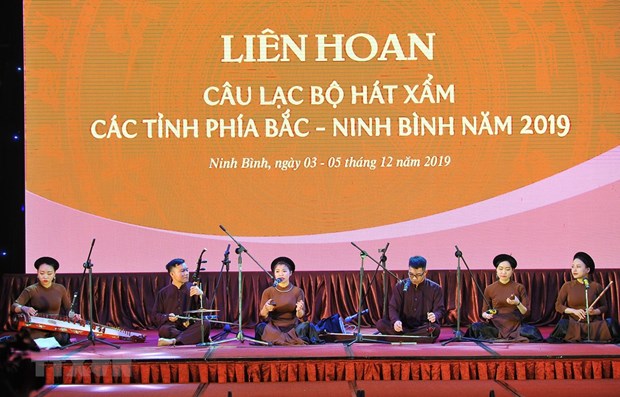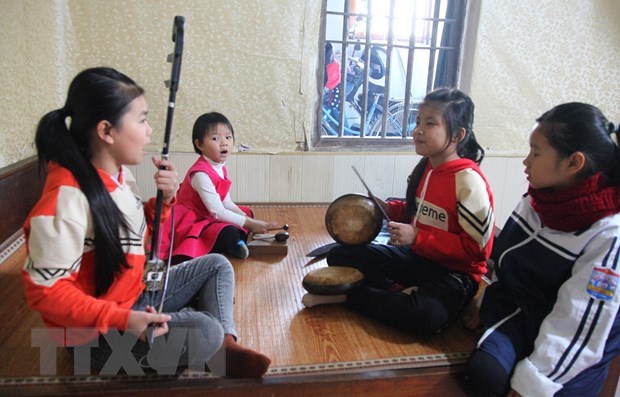Preserving “xam” singing – unique folk music form
 A “xam” performance staged by artists from Thang Long traditional music centre in Hanoi, at the “xam” singing festival of northern regions held in Ninh Binh province (Photo: VNA)
A “xam” performance staged by artists from Thang Long traditional music centre in Hanoi, at the “xam” singing festival of northern regions held in Ninh Binh province (Photo: VNA)
Hanoi (VNA) – “Xam” (blind wanderers’ music) is a centuries-old singing style of the Vietnamese people, which has long been recognised as an important piece of the nation’s cultural heritage.
Like “ca tru” (ceremonial singing), the singer can play musical instruments at the same time. While “ca tru” singers beat castanets while singing, “xam” singers often play Dan bau (monochord) or dan nhi (two-string fiddle).
The singing is mainly found in the countryside and is mostly performed by poor artists who sing for a living, expressing optimism, humour and philosophy about life. The performances stem mostly from northern regions. In the past, most of xam performers were blind.
During the war time and the early 20th century, crowded trams, markets and street corners were turned into stages for buskers.
During a “xam” performance, one artist plays a drum, one plays the castanets, one plays a “dan nhi” (bowed instrument with two strings), one plays a “dan bau” (monochord instrument) and all sing together. Audiences would leave money in the artists’ conical hats for their performance.
Artists from across the country aged 7-70 performed at the "xam" festival on December 3-5, 2019, in the northern province of Ninh Binh – which is considered the cradle of “xam” singing, the hometown of Meritorious Artist Ha Thi Cau (1917-2013), the so-called 'last humane treasure of xam' and the most famous artisan of this genre.
Fifteen clubs had registered to take part in the event – which was designed to preserve and promote the art of singing and introduce the country's traditional heritage to international visitors.
“Xam” clubs and training classes have been opened for people who are interested in the art, including children and elders, according to Director of the provincial Department of Culture and Sports Nguyen Manh Cuong.

Children learn to sing “xam” at the house of late Meritorious Artist Ha Thi Cau, the most famous artisan of this genre (Photo: VNA)
After the festival, the culture departments of Ninh Binh and other northern provinces will send an application to the Ministry of Culture, Sports and Tourism for recognition of ”xam” as a national intangible heritage. It’s the first step to nominate ”xam” as an UNESCO heritage.
Each club presented three pieces, each 15 minutes long. The pieces include both traditional tunes and songs with new lyrics.
“The content of the songs is varied, showing the creativity and professionalism of modern artists,” said musician Thao Giang, head of the jury board.
“The songs reflect patriotism and urgent issues in society such as traffic accidents, sovereignty and maritime territory.”
 A class teaching how to use “xam” instruments in Yen Mo district, Ninh Binh province (Photo: VNA)
A class teaching how to use “xam” instruments in Yen Mo district, Ninh Binh province (Photo: VNA)
Artist Nguyen Linh, 28, from Ninh Binh province, said the artists were eager for the festival as they considered it a chance to exchange with each other and promote the traditional art form.
“I have practised and performed ”xam” for more than 10 years. We want to preserve ”xam” and introduce the art to more people,” he said.
Apart from competitions, a seminar was held as part of the festival with the participation of experts, cultural authorities and ”xam” artists. They discussed how to promote the art form to the world and popularise it among the next generation.
Representatives of the clubs and the organising board also visited late artisan Cau’s house in Yen Mo district, Ninh Binh province.
“Xam” Ha Thanh Group with musician Nguyen Quang Long, singer Mai Tuyet Hoa and other instrumentalists performed at Ly Thai To Garden in Hoan Kiem (Returned Sword) Lake./.













